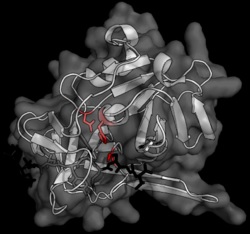Measuring Protease in Metalworking Fluids
 Measuring what? From Wikipedia (their drawing on the left): A protease (also called peptidase or proteinase) is any enzyme that performs proteolysis, that is, begins protein catabolism by hydrolysis of the peptide bonds that link amino acids together in a polypeptide chain. Proteases have evolved multiple times, and different classes of protease can perform the same reaction by completely different catalytic mechanisms. Proteases can be found in animals, plants, bacteria, archaea and viruses. Presenter Jodi Brookes is a PhD student at Sheffield Hallam University. She stated more simply that bacterial protease are enzymes released by bacteria for the digestion of nutrients, that are also involved in the infection processes. Ms. Brooke's work was directed to determining if bacterial proteases detected in used metalworking fluids can be used to monitor the microbial growth in the the fluids and for monitoring worker exposure. She stated that proteases are associated with allergic respiratory irritation and disease in other industrial settings, including detergent, cleaning and sterilizing agents, and baking products. Zymography methods were used to detect proteases within samples, and florescence substrate essay was used for quantifying the proteases. The conclusion of the research was 1) that bacterial protease are detectable in used metalworking fluids, and 2) there is a potential for bacterial proteases to be used as a marker to monitor microbial growth. She indicated that from receipt of a tank sample, she can have an indicator of proteolytic activity within a couple of hours. Because of the geometric growth rate of bacteria, this is an important advantage. There is obviously more research required, but this appears to be is an interesting opportunity that we hope develops into a commercial option.
Measuring what? From Wikipedia (their drawing on the left): A protease (also called peptidase or proteinase) is any enzyme that performs proteolysis, that is, begins protein catabolism by hydrolysis of the peptide bonds that link amino acids together in a polypeptide chain. Proteases have evolved multiple times, and different classes of protease can perform the same reaction by completely different catalytic mechanisms. Proteases can be found in animals, plants, bacteria, archaea and viruses. Presenter Jodi Brookes is a PhD student at Sheffield Hallam University. She stated more simply that bacterial protease are enzymes released by bacteria for the digestion of nutrients, that are also involved in the infection processes. Ms. Brooke's work was directed to determining if bacterial proteases detected in used metalworking fluids can be used to monitor the microbial growth in the the fluids and for monitoring worker exposure. She stated that proteases are associated with allergic respiratory irritation and disease in other industrial settings, including detergent, cleaning and sterilizing agents, and baking products. Zymography methods were used to detect proteases within samples, and florescence substrate essay was used for quantifying the proteases. The conclusion of the research was 1) that bacterial protease are detectable in used metalworking fluids, and 2) there is a potential for bacterial proteases to be used as a marker to monitor microbial growth. She indicated that from receipt of a tank sample, she can have an indicator of proteolytic activity within a couple of hours. Because of the geometric growth rate of bacteria, this is an important advantage. There is obviously more research required, but this appears to be is an interesting opportunity that we hope develops into a commercial option.


